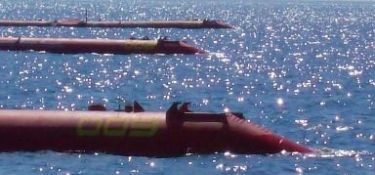|
Wave Power
Wave power generation is yet another form of hydro power. I’m sure you’ve admired the beauty of waves crashing against a beach. And if you’ve ever swum in an ocean, you’ve felt their power. Researchers are exploring many different mechanisms in attempts to turn the power in waves into electricity. A Scottish company has already installed the first successful commercial station off the coast of Portugal. (Portugal supported the project with subsidies because it is very interested in kick-starting production of energy from waves. Given Portugal’s extensive coastline, this makes perfect sense.) Ill talk about these units first because they’re in operation already. Then I’ll mention other generators that are in various stages of development or testing. The World’s First “Wave Farm”Pelamis Wave Power Ltd’s wave generators are anchored off the coast of Portugal. The generators are a series of short tubular structures hinged together to form one large tube about 150 meters long. A number of these units combine to create a wave farm.
Photo courtesy of Pelamis Wave Power Ltd Each tube floats partially submerged on the surface of the water. As waves roll by, the hinged units rock as they conform to the surface of the wave. This motion drives hydraulic pumps which in turn power a hydraulic engine to generate electricity. A submarine cable carries the electricity to shore. In Portugal, it’s already connected to the power grid. Here's a little video of how it works:
Buoys As GeneratorsAnother method already applied in demonstrations and small scale projects uses buoys. As the buoys rise and fall with the waves, the action drives a piston in the center of the buoy that turns a generator. The manufacturer of these devices has installed several test units off the coasts of both Hawaii and New Jersey. Each buoy generates about 40kwatt. In large scale projects, dozens would be located in a limited are and the resultant electricity carried to shore by a single underground cable. Yet another experimental approach uses a polymer cable that produces electricity when it’s stretched. In the experiment, the polymer cable tethers a buoy. As the buoy rides the waves, the repeated stretching and relaxing of the tether generates electricity. An obvious advantage of this approach is that it avoids complex mechanical systems. It’s as yet unclear how much power could be generated using polymers. Rubber Tube GeneratorsAnother very interesting approach currently being tested in wave tanks uses water-filled rubber tubes. An oncoming wave compresses the water in the tube and forms a wave within it. The wave builds along the length of the tube and turns a turbine at the end of it. Here's news report showing models of the system. It's easier to see a picture than to describe it.
The rubber tube is very suitable for marine environment, but turbines have been more problematic. In some tests of tidal current the turbine blades have failed after a relatively short period. However such issues are technical engineering issues that can be worked out. Submerged GeneratorsAWS Ocean Energy has developed an interesting device using what they call Archimedes Wave Swing (tm) technology. Their device is submerged about 15 feet or so under the surface. It contains fluid and air filled section separated by a “floater”. Passing waves compress the air filled section causing the floater to move. This drives a hydraulic system and motor-generator to produce electricity. The manufactures of these generators hope that they will prove to be more cost efficient and dependable than some of the other approaches I’ve mentioned. Difficulties With Wave Power
A major issue troubling hindering the use of these devices to capture wave power is the fact they have to operate reliably in a changing and harsh marine environment. Salt water is very corrosive and weather can be unpredictable. Researchers are exploring several methods hoping to find the best combination of reliably, ease of maintenance and cost effectiveness. Another difficulty is that the requirement of a submarine cable adds significantly to the cost. It also limits where wave farms can be located. Laying cable to some otherwise desirable sites may not be feasible. The wave farms also form a hindrance to shipping and recreational use of the sea. These factors need to be considered when choosing a location for them. All in all though, these factors can all be dealt with in a responsible way. Once again, it is likely that the answer to our energy challenges will come from a flexible, imaginative approach that chooses the most appropriate source of energy for a given situation. LinksClick here to go to Alternative Energy Primer Home from Wave Power |


